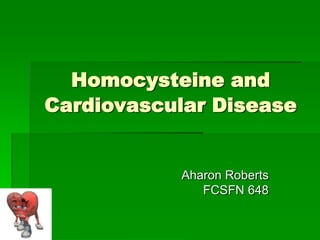
Homocysteine and Cardiovascular Disease Link
- 1. Homocysteine and Cardiovascular Disease Aharon Roberts FCSFN 648
- 2. Homocysteine :Sulfur containing nonessential amino acid that is not found in the diet. Dietary methionine is converted to homocysteine. Methionine Homocysteine NH3+ H l | CH3-S-Ch2-CH2-CH-CO2- → +H3N-C-COO- | CH2-CH2-SH
- 3. Homocysteine Varying forms 1% free 70-80% bound to albumin via a disulfide link 20-30% either as a homocysteine dimer or a cysteine-homocysteine-mixed disulfide. * The type(s) of species responsible for the CVD pathology have yet to be determined.
- 4. Etiology of Hyperhomocysteinemia Causes Genetic mutations Nutritional deficiencies Disease states Drugs
- 5. Etiology of Hyperhomocysteinemia Genetic Mutations 5-methyleneterahydrofolate reductase (MTHFR) polymorphism due to a point mutation on chromosome 1.
- 6. Etiology of Hyperhomocysteinemia Nutritional deficiencies Folate deficiency Cobalamine deficiency Pyridoxine deficiency
- 8. Etiology of Hyperhomocysteinemia Disease states Cystathione β-synthase deficiency Homocysteinuria Methionine synthase deficiency * Both are rare autosomal recessive disorders that are correlated with hyperhomocysteinemia and vascular thrombosis. Chronic renal failure regardless of etiology, duration, or type of dialysis Severe psoriasis Possibly through increased cell turnover Pernicious anemia Cobalamine deficiency
- 9. Etiology of Hyperhomocysteinemia Drugs Cholestryamine (reduces cholesterol in blood) Impairs folate absorption Methotrexate (treatment of psoriasis) Depletes folate metabolites Anti-epileptics (carbemazapine, phenytoin) Lower folate concentrations *Tobacco and caffeinated coffee are also associated with increased homocysteine concentrations
- 10. How Homocysteine effects CVD Homocysteine is one of many damaging agents to endothelial cells LDL and platelets invade Platelets secrete chemoattractants for monocytes PDGF - Platelet derived growth factor stimulates smooth muscle proliferation and thickening of the tunica media. Smooth muscle cells from the tunica media invade the tunica intima. Monocytes invade and are activated to macrophages/scavenger cells.
- 11. How Homocysteine effects CVD Smooth muscle cells and macrophages ingest LDL Foam cells/Fatty streaks The high amounts of cholesterol ester consumed will precipitate into crystalline deposits. Deposits calcify and become rough stimulating clot formation creating a fibrous plaque. Narrows the lumen of the vessels, restricting blood flow.
- 12. Research 1969 – Dr. Kilmer McCully, M.D. Compared an 8 y/o patient with homocysteinuria who died of a stroke and an infant with an inherited defect of cobalamine metabolism who died of cardiac arrest. Concluded that elevated homocysteine levels result in premature atherosclerosis. Later expanded to include general populations with mild hyperhomocysteinemia, typically associated with dietary deficiencies.
- 13. Research VITATOPS Vitamins to Prevent Stroke Stated that an adjustment for renal function eliminated the relationship between total homocysteine levels and intima media thickness as well as flow-mediated dilation of the brachial artery.
- 14. Research VISP Vitamin Intervention for Stroke Prevention Reduction in total plasma homocysteine concentration was reported at 21% in participants after exclusion of those with impaired renal status, those with malabsorption of B vitamins, or those taking other B vitamins not associated with the study.
- 15. Research HOPE Heart Outcomes Prevention Evaluation For patients with vascular disease, B vitamin therapy significantly reduced stroke by 25% but not myocardial infarction or death.
- 16. Research Severe homocysteinuria Treatment with high-dose B vitamins in combination with dietary methionine restriction resulted in markedly reduced results. * Results for mild homocysteinuria have not shown such significant results. Contradictory results may be due to trial design, adverse effects from vitamin supplementation, and using homocysteine as a risk factor or not as a risk factor.
- 17. Reduction in Homocysteine Levels Supplementation of B vitamins Folate, B6, and B12 Restriction of methionine containing substances Sesame seeds, brazil nuts, fish, meats Exercise
- 18. Bibliography Gauthier, G.M., Keevil, J.G., McBride, P.E., The Association of Homocysteine and Coronary Artery Disease. Clin. Cardiol. 2003; 26:563-8. Gropper, S.S., Groff, J.L., and Smith, J.L., Advanced Nutrition and Human Metabolism. 5th Edition, Wadsworth Publishing, 2009. Lavie, C.J., Milani, R.V., Homocysteine The Rubik’s Cube of Cardiovascular Risk Factors. Mayo Clinic Proceedings. 2008; 83(11):1200-02. Scott, J., Weir, D. Homocysteine and cardiovascular disease. Q J Med. 1996; 89:561-3.